
A Brief Ecological History of Hawaiʻi
Beyond being a nice place to park one’s beach chair and umbrella, what is the ecological reality behind postcard Hawaiʻi? Gazing out at the varied landscapes around us, what are we looking at? How did the islands form? How did things become as they are? In terms of ecological health, are the islands thriving, or suffering? In a place that has been so transformed by the hand of humanity in recent centuries, how does one begin to get oriented ecologically, and what does “natural” even mean here?
The answer to “What makes Hawaiʻi, Hawaiʻi?” depends on who you ask, for Hawaiʻi, like beauty, lies in the eye and the mind of the beholder. On a quest for local ecological literacy we turn first to the original authorities – the indigenous Hawaiians. From Polynesian roots a unique Hawaiian culture grew and blossomed for over a millennium, with its own language, cosmology, mythology, and arts. Native planters, fisherfolk, and healers developed a rich knowledge of the island ecosystems, along with values and skills that allowed them to thrive here. They named and recognized the landforms and waterways, the thousands of native and cultivated plants and animals, stars, breezes, and rains. Everything had a name and a meaning, and all was part of a larger, cohesive story that seamlessly wove together human life with land and sea.
As a complement to indigenous knowledge we can also turn to the diverse specialists of today, the geologists, marine biologists, botanists, ornithologists, archaeologists, and various others who delve into the details. And not to be overlooked are the contributions of everyday experts who pay close attention to local nature: kupuna, fishermen, hunters, snorkelers and divers, nature photographers and writers, shell collectors, lei-makers. From all these sources a new story emerges of how the islands came to be, how they have changed over the eons and decades, how they fit into the larger Epic of Evolution, and where things stand today.
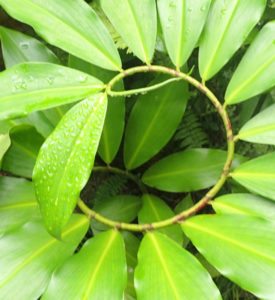 If there is one thing that distinguishes Hawaiʻi in the planetary context it is its role as one of Earth’s most remote evolutionary outposts. The islands’ isolation bred originality – not the most species overall, compared to somewhere like the Amazon basin, but the highest percentage of unique species, packed into a tiny area. In Hawaiʻi, the alchemical workings of evolution were amplified and compressed in both time and space. The resulting mosaic of species and ecosystems begs comparisons, all inadequate: an intricate symphony, an artistic masterpiece, a living art museum.
If there is one thing that distinguishes Hawaiʻi in the planetary context it is its role as one of Earth’s most remote evolutionary outposts. The islands’ isolation bred originality – not the most species overall, compared to somewhere like the Amazon basin, but the highest percentage of unique species, packed into a tiny area. In Hawaiʻi, the alchemical workings of evolution were amplified and compressed in both time and space. The resulting mosaic of species and ecosystems begs comparisons, all inadequate: an intricate symphony, an artistic masterpiece, a living art museum.
Yet the complex ecological mosaic that evolved over millions of years has changed in the blink of an eye. The first wave of changes came a millennium ago with the arrival of Polynesian voyagers, and the plants and animals they brought with them. The second wave, with more sweeping changes, began just over 200 years ago when the Western world “discovered” Hawaiʻi. Since then the ecological transformation of the islands has accelerated. Large areas of native forests have been replaced by monocrop agriculture and cattle pasture. Common plant and animal species from around the world have been imported and have displaced many of the island rarities, gaining Hawaiʻi the title of “extinction capital of the world”.
While much of the islands’ biodiversity has been lost, and much of the rest has been pushed to the margins, Hawaiʻi remains a precious yet imperiled ecological treasure. As we sit perched on the threshold of unprecedented planetary change, big questions arise: How can we live in this place without further damaging it? How can we reinhabit the islands, defending and restoring native ecosystems, while also working with the ʻaina, the living land, to sustain us? A crucial first step is to open our eyes and develop a deeper understanding of where on Earth we are.
Origins in the dark depths
Starting at the foundation, there are two keys to understanding the Hawaiian Islands’ formation: plate tectonics, and the Hawaiian Hot Spot.
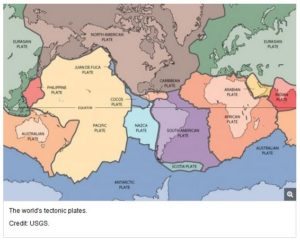 First, plate tectonics. The Earth’s rocky crust, both dry land and the seafloor, is divided into a number of irregularly shaped sections or plates – like a spherical jigsaw puzzle. For billions of years these plates have ‘drifted’ in slow motion on the planet’s semi-fluid mantle. Along some of their margins the plates diverge, and magma seeps upward to form new areas of rocky crust. Elsewhere plates converge and collide, forming buckled and folded mountain ranges. Or one plate may slide beneath an adjacent plate, consumed as it descends into Earth’s fiery interior.
First, plate tectonics. The Earth’s rocky crust, both dry land and the seafloor, is divided into a number of irregularly shaped sections or plates – like a spherical jigsaw puzzle. For billions of years these plates have ‘drifted’ in slow motion on the planet’s semi-fluid mantle. Along some of their margins the plates diverge, and magma seeps upward to form new areas of rocky crust. Elsewhere plates converge and collide, forming buckled and folded mountain ranges. Or one plate may slide beneath an adjacent plate, consumed as it descends into Earth’s fiery interior.
Hawaiʻi lies at the center of the Pacific plate. This plate is continually being created along its southeastern edge at the East Pacific Rise. At the plate’s northwestern margin it descends into the Aleutian Trench, where its crust is recycled into the Earth’s hot mantle layer. As a result, the Pacific plate and Hawaiʻi along with it, are moving to the northwest at around 3 inches per year (or roughly 50 miles every million years).
The second key is the Hawaiian Hot Spot, a plume of magma that emerges from deep within the Earth’s interior. For over 80 million years lava has oozed from the magma plume onto the seafloor, where it piles up to form volcanoes. The name of Hawaiʻi’s native creation chant, the Kumulipo, translates as “beginning in the depths of darkness”. And so began the history of every Hawaiian Island past and present, in the darkest depths of the ocean, some 15,000 feet beneath the surface.
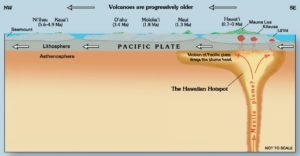 As the Pacific plate slowly creeps over the Hawaiian Hot Spot new volcanoes and islands continually form, and the older ones are carried off to the northwest. The result is the Hawaiian-Emperor volcano chain, a 3600-mile ridge of seamounts, coral atolls, banks, reefs, and tall volcanic islands that extends halfway across the northwestern Pacific. New volcanoes and islands are created at the southeastern end of the chain, at the hot spot’s multiple vents. The youngest island in the chain, Hawaiʻi (the Big Island), is still being formed as the Kilauea Volcano spills fresh lava day and night. Younger still is the Lōʻihi seamount 22 miles off the southeastern coast of the Big Island, which is not projected to rise above the sea surface for another 50,000 years or more.
As the Pacific plate slowly creeps over the Hawaiian Hot Spot new volcanoes and islands continually form, and the older ones are carried off to the northwest. The result is the Hawaiian-Emperor volcano chain, a 3600-mile ridge of seamounts, coral atolls, banks, reefs, and tall volcanic islands that extends halfway across the northwestern Pacific. New volcanoes and islands are created at the southeastern end of the chain, at the hot spot’s multiple vents. The youngest island in the chain, Hawaiʻi (the Big Island), is still being formed as the Kilauea Volcano spills fresh lava day and night. Younger still is the Lōʻihi seamount 22 miles off the southeastern coast of the Big Island, which is not projected to rise above the sea surface for another 50,000 years or more.
The rise and fall of Hawaiʻi’s volcanoes
The Hawaiian archipelago has been shaped by opposing forces, construction and destruction. The islands are built up papier-mâché style, one thin lava flow at a time. The result of thousands of overlapping lava flows is a massive broad dome, a shield volcano. Yet simultaneous with a shield volcano’s growth and ascent are the downward forces of landslides, subsidence, and erosion. Enormous landslides – among the largest documented on Earth – have resulted in the steep slopes of Molokaiʻs northeastern coast and the 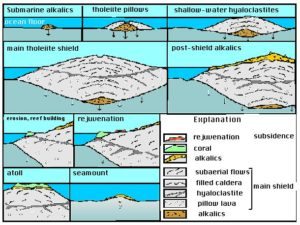 eastern face of Oʻahu’s Koʻolau Range Beneath the ocean surface, fans of rock debris from submarine avalanches extend for over 100 miles away from the islands. In some cases the catastrophic landslides are believed to have caused massive tsunami waves of up to 1000 feet!.
eastern face of Oʻahu’s Koʻolau Range Beneath the ocean surface, fans of rock debris from submarine avalanches extend for over 100 miles away from the islands. In some cases the catastrophic landslides are believed to have caused massive tsunami waves of up to 1000 feet!.
Subsidence occurs when the ocean floor actually sags under the weight of a volcanic island. This is understandable, since the Hawaiian shield volcanoes are some of the most massive structures on Earth. In fact, the Big Island’s Mauna Kea and Mauna Loa, in addition to Maui’s Haleakalā, are actually taller than Mt. Everest when they are measured from the seafloor!
Erosion begins as soon as a volcanic island rises above the sea surface. Waves pound the island’s shores, eventually forming features that include sea stacks and arches. Flowing water carves gullies that will eventually become stream valleys. Today the islands have a fantastic array of landforms, from the ‘young’ shield volcanoes of the Big Island, to the heavily eroded mountains, canyons, and knife-edge ridges of the older islands.
On a larger scale, erosion and subsidence have changed the islands’ overall configuration. For example, Maui is the second-youngest and currently the second-largest of the Hawaiian Islands. Yet for most of its existence Maui was part of a much larger land mass referred to as Maui Nui (Big Maui). At its largest extent, 1.2 million years ago, ancient Maui Nui was 40% larger than today’s Big Island, and also encompassed the islands of Lanaʻi, Molokaʻi, and Kahoʻolawe. For a time Oʻahu was even connected to Molokaʻi.
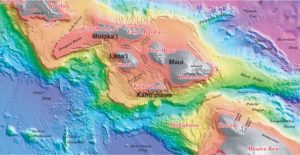
In the intervening millennia erosion and subsidence have led to the breakup of Maui Nui. During the alternating glacial and interglacial periods of the Pleistocene, Maui, Lanaʻi, and Molokaʻi were repeatedly unified and separated as sea levels fell and rose. The most recent Maui Nui land bridge is estimated to have occurred 18,000 years ago at the height of the last Ice Age.
Eventually the mountainous islands of today will be worn down to sea level just like the northwestern Hawaiian Islands are today. And for as long as plate tectonics and the Hawaiian Hot Spot are functioning, new islands will be forming all the time to replace the older ones.
The arrival of life
Had you been a giant pterosaur cruising over just the right spot in the central Pacific some 80 million years ago or more, you may have noticed a faint smell of hydrogen sulfide or some other gaseous cocktail on the breeze. Investigating more closely, you may have discovered a plume of steam and ash rising thousands of feet from the ocean’s sputtering and explosive surface, marking the emergence of the first Hawaiian Island from the blue depths.
Having already risen from the seafloor for a million years or more, the slopes of the first Hawaiian seamount were likely discovered by marine life long before any hot lava rock breached the surface. For marine currents carry tiny creatures to even the most remote parts of the oceans, things like larval crustaceans, bits of coral, or seaweeds.
As for the original life on dry land, no one knows which species arrived first in Hawaiʻi. Some insight into the island’s colonization by terrestrial lifeforms can be gleaned from the planet’s recently formed islands, like Surtsey, which formed in 1963 off the southern coast of Iceland. By 1965 the first vascular plant had colonized the bare lava, followed in subsequent years by mosses, lichens, and fungi. Early visits by birds brought seeds and valuable nutrients for soil development, and by 2008, 30 plant species had become established on the island. Marine species like starfish, urchins, and seaweed abound, as well as larger species like seals.
While this sheds some light on island colonization, it is important to keep in mind that Surtsey lies only 20 miles or so from the Icelandic coast, compared to Hawaiʻi’s 2500 miles from the nearest continent or high island group. The odds of any species reaching Hawaiʻi are therefore much smaller.
The original plant and animal species that arrived in Hawaiʻi (or the earlier Emperor chain) did so via wind, water, or on the wing. The lucky arrivals came from all directions, with some arriving from Asia and North America, and 85% or more from the Indo-West Pacific region. Wind brought fungal and algal spores, and helped insects and even birds reach the islands. Birds brought plant seeds, either in their gut or embedded in muddy feathers or feet. Marine species were carried by ocean currents, while others likely hitched a ride on mats of floating vegetation.
Evolution’s playground
Successful plant and animal colonizations in Hawaiʻi were extremely rare. But what was challenging for colonization – vast travel distances and small target islands -- was good for evolution. Each new island that emerged above the waves provided a blank canvas for life’s creative expression. For the few species that were able establish a foothold in the islands, the opportunities for populating new niches and evolving into new species were vast. It is estimated, for example, that Hawaiʻi has around 1,000 species of native flowering plants, and 90% of those are endemic, having evolved from only a handful of founder species.
In some cases plant evolution truly went wild in the islands, the most impressive being that of the Lobeliad plant family. With at least 126 species, the Hawaiian lobelias are the largest plant species group to inhabit any archipelago in the world, and all are derived from a single founder species that arrived in the islands around 13 million years ago. Inhabiting moist and wet forests on volcanic slopes, the largest lobeliad genus, Cyanea, has its maximum species diversity on Maui.
Hawaiian lobeliads are a prime example of adaptive radiation. Under this type of evolution, the single founder species spread out into varied habitat types at different elevations, and gradually developed new growth forms – including trees, succulents, vines, and epiphytes – with a variety of specialized flowers and other features. As the Hawaiian lobeliads filled new niches they also became “keystone mutualist species”, instigating further adaptive radiation in their pollinator species, including birds, hawk moths, and flies.
Other exceptional examples of evolution in Hawaiʻi include:
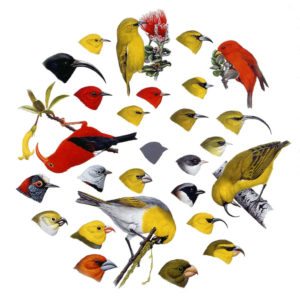
courtesy http://www.hdouglaspratt.com
The Hawaiian Honeycreepers. With well over 50 species emerging from a single ancestor over the span of 5 million years, the honeycreepers represent the most spectacular example of rapid bird species evolution anywhere in the known universe. Darwin’s famous Galapagos finches were a group of only 15 species and were comparatively similar to one another. The honeycreepers’ explosive creativity resulted in an array of beak shapes and functions: small thin beaks for hunting insects among the foliage; heavy beaks for cracking hard seeds; specialized beaks for peeling back tree bark; the twig-snapping grub-grasping beak of the Maui parrotbill (kiwikiu); the scarlet iʻiwi’s sickle shaped bill, perfect for sucking nectar from tubular Lobelia flowers.
Haleakalā’s round-waisted predatory beetles. Thought to be descended from a single Australian species these Mecyclothorax beetles have radiated into 239 Hawaiian species in less than 2 million years – a riotous rate of evolution. Their center of diversity is found in the rain forests, ravines, and bogs of windward Haleakalā on Maui, and 116 species are found on that one volcano alone. Twenty species are found in an area just over one square mile making them one of the most geographically dense collections of similar species in the world. They can be found in clumps of moss on branches of 'ōhi'a trees, underneath bark, or in leaf litter on the forest floor. Unlike their continental cousins, these beetles do not fly, having only vestigial wings.
Drosophila flies. Famous as the go-to ‘fruit fly’ species for laboratory studies in genetics, Hawaiʻi has over 800 drosophilids, and more than 90 percent of those are single-island species. Among these are the Hawaiian picture-wing flies, known for their ‘stained glass’ wing patterns and elaborate courtship displays involving dancing, singing, and head-butting. A number of Hawaiian drosophilids are documented “recolonizers” – lineages that colonized Hawaiʻi, evolved into new species, and then reversed the trend by colonizing other island groups and continents
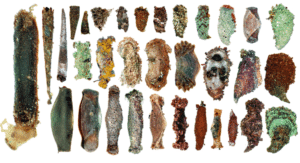 Hawaiian Hyposmocoma moths. Here is another remarkable example of insect evolution, with over 350 species found only in the islands. Also known as “fancy-cased caterpillars”, the moth larvae are known for the diverse protective cases (like cocoons) they spin from silk. These colorful cases have forms that have been categorized as cigars, cones, bugles, and burritos. On Maui and Molokaʻi, certain Hyposmocoma caterpillars have developed the ability to entrap snails in a
Hawaiian Hyposmocoma moths. Here is another remarkable example of insect evolution, with over 350 species found only in the islands. Also known as “fancy-cased caterpillars”, the moth larvae are known for the diverse protective cases (like cocoons) they spin from silk. These colorful cases have forms that have been categorized as cigars, cones, bugles, and burritos. On Maui and Molokaʻi, certain Hyposmocoma caterpillars have developed the ability to entrap snails in a 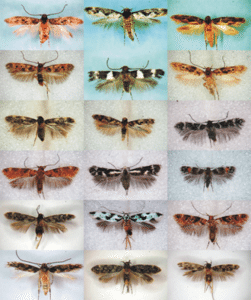 silky web. From there the caterpillars crawl into the snail’s shell where they eat their prey alive. Even more jaw-dropping are the handful of species whose larvae have acquired amphibious abilities. They spend up to a month underwater in rushing streams, absorbing oxygen directly into their soft bodies – true amphibious caterpillars!
silky web. From there the caterpillars crawl into the snail’s shell where they eat their prey alive. Even more jaw-dropping are the handful of species whose larvae have acquired amphibious abilities. They spend up to a month underwater in rushing streams, absorbing oxygen directly into their soft bodies – true amphibious caterpillars!
Terrestrial Snails. Known as “jewels of the forest” for their dazzling variety of shell colors, patterns, and shapes, Hawaiian land and tree snails once numbered over 750 species. Weekend shell collecting expeditions were a common pastime in the latter half of the 19th century. Sadly an estimated 90% have already been driven extinct by habitat loss, overcollection, and invasive carnivorous snail species.
Reef fishes. While shallow reefs have around 20% endemic species (found only in Hawaiʻi), deeper reefs such as those of the northwestern islands’ Papahānaumokuākea Reserve have 50% or more endemic species – a higher rate than anywhere else in the world. Hawaiian endemics include such rock stars as the bandit angelfish, scarface blenny, fantail filefish and psychedelic wrasse.
Hawaiʻi’s mosaic of natural landscapes
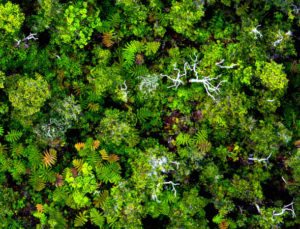 Hawaiʻi’s diversity of species is mirrored by its diversity of ecosystems, with over 175 distinct natural community types identified. From snow-capped alpine summits, to cloud forests, to unique coastal pools, the islands’ natural landscapes are a patterned mosaic, shaped by climate, elevation, and topography. Prevailing northeasterly trade winds bring copious rainfall to the windward slopes of Maui and the Big Island, and the summits of Molokaʻi, Oʻahu, and Kauaʻi. Here are found some of the wettest places on Earth, supporting a variety of rainforest communities and boggy areas. Trees such as koa and ʻōhiʻa lehua thrive on the moist and wet mountain slopes, with moss-covered tree trunks, tree ferns, and rare plants in the understory.
Hawaiʻi’s diversity of species is mirrored by its diversity of ecosystems, with over 175 distinct natural community types identified. From snow-capped alpine summits, to cloud forests, to unique coastal pools, the islands’ natural landscapes are a patterned mosaic, shaped by climate, elevation, and topography. Prevailing northeasterly trade winds bring copious rainfall to the windward slopes of Maui and the Big Island, and the summits of Molokaʻi, Oʻahu, and Kauaʻi. Here are found some of the wettest places on Earth, supporting a variety of rainforest communities and boggy areas. Trees such as koa and ʻōhiʻa lehua thrive on the moist and wet mountain slopes, with moss-covered tree trunks, tree ferns, and rare plants in the understory.
The leeward slopes and lower islands such as Lanaʻi and Kahoʻolawe were originally cloaked with a tropical dry forest. This forest type once supported the highest tree species diversity in the islands, but is now among the most threatened of Hawaiian landscapes. Extensive dry forests were once widespread on leeward “rain shadow” slopes of the high islands. Forests with forty or more tree species, including wiliwili, lama, and naio, once supported Hawaiian honeycreepers and extinct flightless birds such as the goose-like moa-nalo.
With increasing elevation on the volcanic slopes, closed forest grades into open parkland or subalpine shrubland. From 6000 feet to the treeline at 9000 feet, the mixed shrublands occupy a drier zone than the wet windward forests. Shrubs of this zone include mamane, pukiawe, ‘ohelo, and aʻaliʻi. In some areas shrubs are replaced by native Deschampsia grasslands.
Other natural communities of the islands include montane bogs and coastal wetlands, sand dune plant communities, lava tube caves, and wet and dry cliff ecosystems. Intact freshwater streams support a number of native fish and crustacean species that spend the juvenile portion of their life in the open ocean, before returning upstream for adulthood.
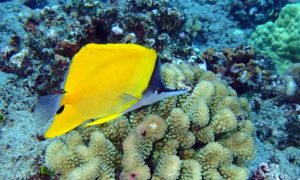
Intertidal and marine environments provide a multitude of habitats: tide pools on lava benches, wave surge zones, seagrass beds, sandy beaches, reef flats, and deepwater rubble slopes.
With so many types of climate and ecological zones packed into such a small area, Maui and the other large Hawaiian islands truly resemble miniature continents, microcosms of the living planet.
Enter the Polynesians
Imagine being the very first Polynesian seafarers to reach Hawaiʻi over a thousand years ago. It must have been like arriving in a mythical enchanted place. Seas teeming with life, flocks of noisy seabirds, breaching whales. Beaches that had never seen a human footprint. Pristine forests and rivers in their wild splendor. Large flightless birds without fear of humans.
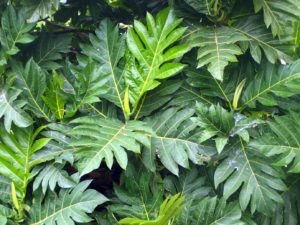 Soon enough the landscape would begin to show the imprint of humankind – and the various other species that arrived on the voyaging canoes. The discoverers came prepared, bringing over 20 so-called ‘canoe plants’ that would provide food, fiber, medicine, containers, and building materials. Among the food plants brought to the islands were taro, yam, sweet potato, sugar cane, banana, and mountain apple, as well as multi-use plants like coconut, ti leaf, and noni, gourds and bamboo. The candlenut or kukui tree provided oil-rich seeds that burned like candles, and wauke (paper mulberry) was cultivated as a source of tapa cloth. A number of these plants became naturalized in the lowland forests, where they are still common today.
Soon enough the landscape would begin to show the imprint of humankind – and the various other species that arrived on the voyaging canoes. The discoverers came prepared, bringing over 20 so-called ‘canoe plants’ that would provide food, fiber, medicine, containers, and building materials. Among the food plants brought to the islands were taro, yam, sweet potato, sugar cane, banana, and mountain apple, as well as multi-use plants like coconut, ti leaf, and noni, gourds and bamboo. The candlenut or kukui tree provided oil-rich seeds that burned like candles, and wauke (paper mulberry) was cultivated as a source of tapa cloth. A number of these plants became naturalized in the lowland forests, where they are still common today.
The early Polynesian navigators also brought select animal species like dogs, chickens, and pigs, plus some that likely arrived as stowaways including Polynesian rats and a few lizard species. The ecological impacts of pigs, chickens, and dogs in the early Polynesian period are thought to have been relatively minor compared with later waves of introduced animals. The Polynesian rat, however, may have had a significant impact on native ecosystems by eating plant seeds and seedlings, as well as preying on native ground birds and their eggs. Many of these birds -- flightless ducks, geese, ibis, and others – went extinct after humans arrived, likely due to the combined impacts of hunting, rats, and the destruction of lowland forests.
Early Hawaiian agriculture is thought to have used swidden (slash and burn) methods, where small plots were cultivated for a time, and then left to go fallow. In this period, sustenance would have largely been provided by the abundant marine life, including reef fish, shellfish, and seaweeds.
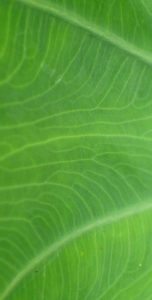 With time, Hawaiʻi’s native population increased, and agricultural methods and land use were intensified. In wet valleys, streamflow was diverted into a complex system of irrigation works and flooded plots (loʻi) for wetland taro cultivation. Prime upland areas were also planted with sweet potatoes, dryland taro, and other crops such as banana and ʻulu (breadfruit). In addition to the irrigation works, Hawaiians’ engineering skills also extended to coastal wetlands and nearshore shallows, where fishponds were built. These ponds were enclosed by hand-built stone walls and had sluice gates that regulated the passage of fish between the ponds and ocean.
With time, Hawaiʻi’s native population increased, and agricultural methods and land use were intensified. In wet valleys, streamflow was diverted into a complex system of irrigation works and flooded plots (loʻi) for wetland taro cultivation. Prime upland areas were also planted with sweet potatoes, dryland taro, and other crops such as banana and ʻulu (breadfruit). In addition to the irrigation works, Hawaiians’ engineering skills also extended to coastal wetlands and nearshore shallows, where fishponds were built. These ponds were enclosed by hand-built stone walls and had sluice gates that regulated the passage of fish between the ponds and ocean.
Beyond their cultivated areas, it is also thought that Hawaiians changed the islands’ native landscapes through their intentional use of fire. Early European visitors noted that Hawaiians would set fires to encourage the regrowth of pili grass, which was used as a roof thatch material. This activity, plus cutting trees for house construction, canoe building, and especially firewood, appears to have gradually had a substantial impact on lowland forests and coastal vegetation. Higher elevation ecosystems, however, were likely minimally impacted prior to European contact, and even in many lowland areas, at least some examples of native ecosystems remained.
The extent to which native Hawaiian ecosystems and species continued to thrive is all the more impressive when one considers that the islands’ pre-European population has been estimated at 300,000-800,000 or more people. This was made possible in part by the Hawaiians’ lack of grazing livestock, but also by their specialized agricultural knowledge and techniques. For crops such as taro – traditionally referred to by Hawaiians as their ancestor or elder brother – native farmers were said to have grown up to 300 varieties, many of which were developed in Hawaiʻi. For taro, sweet potato and other crops, there were crop varieties, cultivation techniques, and planting calendars specific to the islands’ varied microclimates. This level of horticultural mastery was made possible by the Hawaiians’ highly refined observation, taxonomy, and plant breeding skills, as well as their knowledge of island soil and weather conditions.
Native Hawaiians’ food and resource self-sufficiency was rooted in an overall approach to landscape management called the ahupuaʻa system. The ahupuaʻa were land areas that usually corresponded to the watershed of a given stream, often resulting in land units shaped like slices of a pie. In this way each ahupuaʻa encompassed a spectrum of ecological resource zones including alpine, montane, lowland, coastal and even offshore areas, and provided the subsistence base for an extended family or community. Knowing that the survival of one’s family depended on the ecological health of a particular area certainly promoted soil and water conservation, as well as an overall sense of responsibility, reverence, and caring for that place. This combination of knowledge, skills, and values allowed the Hawaiians to thrive in island ecosystems for an entire millennium.
The Euroamerican Transformation of Hawaiʻi
Captain Cook arrived in the islands in 1778, and for both the Hawaiians and their land, changes rapidly followed. In addition to introducing goats to the islands, Cook’s expedition also brought venereal diseases to the natives. Cook was followed in turn by increasing numbers of Europeans who brought smallpox, measles, whooping cough, and influenza. These diseases led to the decimation of the Hawaiian population over the next century, and the decline of cultural practices that had kept native ecosystems relatively intact.
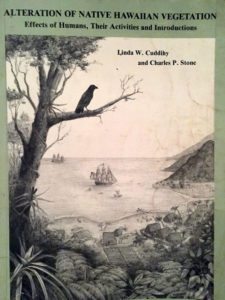 In the first half of the 19th century the biggest impacts to Hawaiian ecosystems came from introduced livestock. The native forests evolved without hoofed mammals, the largest indigenous herbivore being the moa-nalu – a 3-foot high goose with a jagged beak that went extinct centuries before the Europeans arrived. This changed suddenly when George Vancouver brought Hawaiʻi’s first cattle to the Big Island in 1793. The long-horned cattle were allowed to roam and reproduce freely for their first 10 years in Hawaiʻi, and before long, large herds of feral cattle were free-ranging on the main Hawaiian Islands. The cattle degraded montane forests that had been scarcely impacted by native Hawaiians, compacting soil, trampling roots, and damaging native plants in the understory.
In the first half of the 19th century the biggest impacts to Hawaiian ecosystems came from introduced livestock. The native forests evolved without hoofed mammals, the largest indigenous herbivore being the moa-nalu – a 3-foot high goose with a jagged beak that went extinct centuries before the Europeans arrived. This changed suddenly when George Vancouver brought Hawaiʻi’s first cattle to the Big Island in 1793. The long-horned cattle were allowed to roam and reproduce freely for their first 10 years in Hawaiʻi, and before long, large herds of feral cattle were free-ranging on the main Hawaiian Islands. The cattle degraded montane forests that had been scarcely impacted by native Hawaiians, compacting soil, trampling roots, and damaging native plants in the understory.
Goats were equally harmful, from lowland dry forests all the way up to alpine environments. They were capable of denuding native vegetation, causing extensive erosion and siltation of reefs and fishponds. In addition to goats and cattle, sheep were also introduced to Hawaiʻi in the 1790s. Raised extensively on Lanaʻi, Niʻihau, the Big Island, and Kahoʻolawe, sheep removed woody vegetation, leading to erosion of topsoil and converting soils to a sun-baked red hardpan.
As the native Hawaiian population plummeted during the 19th Century, the ahupua’a system of land stewardship faded, and extractive land uses took over. The early part of the century was marked by logging for the sandalwood trade, in which shiploads of the fragrant wood were exported to China. Additional pressure was put on the islands’ dry and moist forests during Hawaiʻi’s whaling era (1820-70). The whalers needed large quantities of firewood to render whale oil, and as a result the hillsides around Lahaina and other port towns were deforested.
As harmful as the effects of livestock and logging were, the wholesale destruction of Hawaiian forests only accelerated with the arrival of commercial export agriculture. The catalyst came in 1848, when the “Great Mahele” land reform enabled non-Hawaiians to acquire and own land in Hawaiʻi. The cultivation of sugar accelerated in the 1870s, and pineapple around the turn of the century. Large-scale irrigation works allowed vast areas to be cultivated as monocrop systems. Forests were extensively cleared for cane and pineapple fields, and additional areas were deforested to provide fuel for the wood-fired boilers in sugar mills. Plantation workers were imported, mostly from Asia.
Also around the turn of the century several large cattle ranches were established in the islands. Native forests were cleared, replaced by alien grasses and legumes such as broomsedge and kikuyu grass. In response to feral ungulates destroying forests, fence-building and reforestation efforts were underway as early as the late 19th and early 20th centuries. After 1904, forest reserves were created to protect watersheds, but the species planted were often fast-growing invasive tree species.
The last hundred years in Hawaiʻi have been marked by the widespread introduction of alien species into the islands:
- Alien plants. Several hundred species of non-native plants have become naturalized, including dozens of problem invasives. Plants including banana poka, miconia, gingers, strawberry guava, grasses, koa haole, and lantana have been able outcompete native plants for water, sunlight, and nutrients;
- Black rats. Arriving in the islands in the late 1800s, they cause major harm to native plants, girdling branches and eating seeds, as well as killing native birds or eating their eggs.
- Asian mongoose. Imported in an attempt to control rats in the sugarcane fields, these predators instead had a major impact on ground-nesting native birds.
- Axis deer. Originally from India, they were introduced to Molokaʻi and Oʻahu in the late 1800s. Introduced to Maui in the 1950s, their population continues to swell.
- Alien bird species. Over 50 non-native bird species reproduce in the wild in Hawaiʻi, and compete with the native bird population for food and habitat. Non-native birds also serve as a disease vector for avian malaria, which is fatal to native birds. While non-native birds spread weed seeds, there is also evidence that they help distribute seeds of native plant species;
- Alien insects. Problem varieties include moths, weevils, bees, flies, and ants. Some compete with or prey on native insects, and others can spread fungus and other plant diseases.
Habitat degradation and the arrival of alien species can often have domino effects. For example, the spread of invasive species like strawberry guava and non-native earthworms provides additional food sources for feral pigs, allowing them to expand their range deeper into native forests. The pigs, in turn, eat native plant shoots, transport alien plant seeds, and create muddy trails that serve as seedbeds for the alien plants. Pools of standing water created by rooting pigs also create habitat for the mosquitoes that carry avian malaria.
On a positive note, many of these issues are now well understood, and conservationists are hard at work to address them. Large areas of native forests are being managed to exclude invasive species, and collaborative watershed protection has made great strides in recent years. Efforts are underway to restore Hawaiian ecosystems, and bring native plants, birds, and other species back from the brink of extinction.
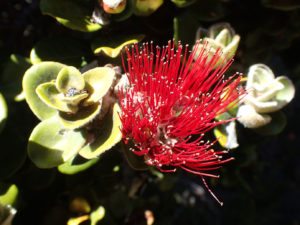 Meanwhile new challenges continue to arise. A recent concern that has so far evaded solution is rapid ʻōhiʻa death, a disease affecting the islands’ most important native tree species, the ʻōhiʻa (or ʻōhiʻa lehua) tree. First identified in 2014, the fungal disease has been spreading rapidly on the Big Island, where tens of thousands of acres have been affected. The ʻōhi'a is a vital source of food and habitat for several native birds and insects. The loss of ʻōhiʻa and replacement with non-native trees would have widespread impacts on island biodiversity. Efforts are underway to contain the disease, but there is no known remedy.
Meanwhile new challenges continue to arise. A recent concern that has so far evaded solution is rapid ʻōhiʻa death, a disease affecting the islands’ most important native tree species, the ʻōhiʻa (or ʻōhiʻa lehua) tree. First identified in 2014, the fungal disease has been spreading rapidly on the Big Island, where tens of thousands of acres have been affected. The ʻōhi'a is a vital source of food and habitat for several native birds and insects. The loss of ʻōhiʻa and replacement with non-native trees would have widespread impacts on island biodiversity. Efforts are underway to contain the disease, but there is no known remedy.
A War on the ʻAina
Hawaiʻi’s population has steadily grown over the past hundred years, and has doubled over the past 50 years to 1.4 million. This increase has been coupled with urban and suburban sprawl, especially on Oʻahu where forests and agricultural lands have been converted to housing subdivisions, military installations, and commercial areas. From the 1960s onward, the tourism industry expanded on all the main islands, bringing additional development to coastal areas, and replacing natural habitats with hotels, restaurants, parking lots, and golf courses.
The decades after World War II saw the industrialization of commercial agriculture in Hawaiʻi, with increased use of chemicals fertilizers, herbicides and pesticides. Direct effects included contaminating groundwater, harming pollinators, and killing soil microorganisms. Monocrop agriculture also impacted ecosystems and human health beyond field boundaries via herbicide overspray, soil erosion, and reef sedimentation. Decades of burning sugar cane fields on Maui – complete with plastic irrigation lines – polluted the island’s air. Barren and contaminated soil was repeatedly exposed and removed as red clouds of dust that settled on neighboring communities and nearshore waters.
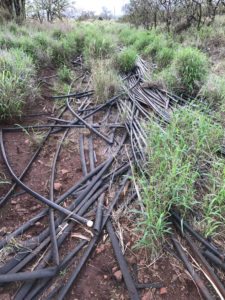 Soil food webs are the basis for terrestrial ecosystems, where nutrients are recycled and made available for plants and ultimately animals, including humans. Commercial agriculture has effectively conducted a war on Hawaiʻi’s soils, leaving them compacted, contaminated, and stripped of microorganisms and nutrients. With the decline of pineapple and sugarcane cultivation, large areas of degraded lands remain. No longer irrigated, these lands are colonized by drought-resistant invasive grasses and shrubs, and are highly fire-prone.
Soil food webs are the basis for terrestrial ecosystems, where nutrients are recycled and made available for plants and ultimately animals, including humans. Commercial agriculture has effectively conducted a war on Hawaiʻi’s soils, leaving them compacted, contaminated, and stripped of microorganisms and nutrients. With the decline of pineapple and sugarcane cultivation, large areas of degraded lands remain. No longer irrigated, these lands are colonized by drought-resistant invasive grasses and shrubs, and are highly fire-prone.
In recent decades Hawaiʻi has seen a growing presence of major transnational seed and agrochemical companies, including Monsanto, Dow, Syngenta, BASF, and DuPont-Pioneer. These companies are using Hawaiʻi as an open-air laboratory for genetically modified crops, largely corn and soy. According to a 2015 report by the Center for Food Safety, after sugarcane and pineapple, seed crops take up 72% of the remaining planted area in the islands.
In addition to the potential dangers of genetically modified crops for human health and the environment are the dangers posed by using a wide variety of toxic agrochemicals at high volumes. Most of the seed crop research is aimed at creating herbicide resistant crops, and the experiments require exposing crops to an intense regimen of pesticide spraying. Along with glyphosate (the active ingredient of Monsanto’s Roundup), several restricted-use chemicals are used, including alachlor, atrazine, chlorpyrifos, methomyl, metolachlor, paraquat, and permethrin. Atrazine and paraquat are both banned in Europe, yet millions of tons are still being applied in Hawaiʻi each year. These chemicals end up in the islands’ soils, streams, groundwater, and oceans – as well as drifting into nearby neighborhoods and schoolyards. According to an American Academy of Pediatrics study cited in the Center for Food Safety report, pesticides have been linked to “childhood cancers, neurobehavioral and cognitive deficits, adverse birth outcomes, and asthma”.
On Maui there is currently concern that the end of the island’s sugarcane industry will open up additional acreage for the expansion of the seed crop industry, as happened on Kauaʻi following sugar’s decline.
Hawaiian ecosystems under a rapidly changing climate
Beyond the immediate threats to Hawaiʻi’s natural environment are those looming impacts associated with global climate change. The potential changes will affect all areas from high elevation forests to beaches, and from coral reefs to the open ocean.
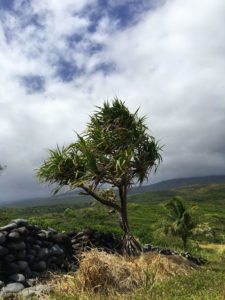 On land, climate models predict warmer and drier conditions – at least in the already dry parts of the islands. Wet areas may become wetter, and episodes of more intense rainfall are expected, making flooding more common. Warmer and drier conditions will pose a challenge to native plants and animals that are unable to adapt quickly enough or relocate. Warmer temperatures will allow the spread of avian malaria higher up the volcanic slopes, impacting endangered forest birds that hold no immunity to the imported disease. This is especially a concern on Kauaʻi where there are no high elevation mountains for birds to take refuge in.
On land, climate models predict warmer and drier conditions – at least in the already dry parts of the islands. Wet areas may become wetter, and episodes of more intense rainfall are expected, making flooding more common. Warmer and drier conditions will pose a challenge to native plants and animals that are unable to adapt quickly enough or relocate. Warmer temperatures will allow the spread of avian malaria higher up the volcanic slopes, impacting endangered forest birds that hold no immunity to the imported disease. This is especially a concern on Kauaʻi where there are no high elevation mountains for birds to take refuge in.
Endangered forest birds are also vulnerable to the increasingly intense storms that are likely to reach the islands. Tropical storm and hurricane-force winds impact forests and make them more susceptible to invasive plants, further degrading bird habitat. Kauaʻi’s native thrush, the kamaʻo, has not been seen since Hurricane Iniki damaged the island’s forests in 1992.
Rising sea levels threaten Hawaiʻi’s beaches and varied coastal habitats. Recent measurements of polar melting have led to a doubling of predicted sea level rise, up to 3-6 feet by 2100. If greenhouse gas emissions continue at current rates, several dozen feet of sea level rise can be expected in the next few centuries. In places where coastal ecosystems are squeezed between the sea and developed areas, rising sea levels will leave nowhere for plants and animals to go. Contamination from the inundation of coastal cities and infrastructure – roads, gas stations, power plants, etc – is likely to become an increasing concern. Waikiki and much of downtown Honolulu, for example, may well be under water by century’s end. Debates are already underway over the logic of trying to temporarily protect highways, condos, and homes with expensive seawalls that degrade coastal habitats.
Up to this point most of the heat that has been trapped in the Earth system by global warming– around 93% -- has been stored in the oceans. Rising ocean temperatures threaten the survival of coral reefs globally and in Hawaiʻi. When waters become too warm, the relationship between coral polyps and symbiotic algae breaks down, resulting in “coral bleaching”, and leaving reefs in a vulnerable state. Record heat in 2015-16 led to a major global coral bleaching event that impacted Hawaiʻi and the western Pacific, where over 90% of Australia’s Great Barrier Reef was affected. Future warming is predicted to make bleaching events more common, and globally corals and the many reef species that depend on them are at risk of extinction in this century.
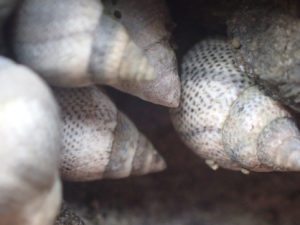 By burning fossil fuels and dumping greenhouse gases into the atmosphere, industrial civilization is altering not only the global climate, but also the chemical composition of the planet’s atmosphere and oceans. Atmospheric carbon has been increasing more rapidly than at any other time for millions of years, and much of this carbon is being dissolved into the oceans. This results in ocean acidification, a process that is damaging to shellfish, marine plants, and plankton that are vital to marine ecosystems. Ocean acidification also reduces coral’s ability to regrow after bleaching events.
By burning fossil fuels and dumping greenhouse gases into the atmosphere, industrial civilization is altering not only the global climate, but also the chemical composition of the planet’s atmosphere and oceans. Atmospheric carbon has been increasing more rapidly than at any other time for millions of years, and much of this carbon is being dissolved into the oceans. This results in ocean acidification, a process that is damaging to shellfish, marine plants, and plankton that are vital to marine ecosystems. Ocean acidification also reduces coral’s ability to regrow after bleaching events.
Ocean acidifcation has been identified as a likely cause of a number of previous mass extinction events in Earth’s history. Among these events was “the Great Dying” at the end of the Permian geological period, 252 million years ago. In that episode an estimated 96% of all marine species went extinct, along with 70% of terrestrial vertebrate species.
If we continue burning fossil fuels and clearing forests, humanity runs the risk of causing a Permian-style extinction event in the years ahead. In addition to ocean acidification, pumping more carbon into the oceans and raising ocean temperatures is also predicted to alter the metabolic activities of key ocean bacteria responsible for maintaining the ocean’s nitrogen cycle and atmospheric sulphur cycles. Warming oceans are also less able to retain dissolved oxygen, further impacting marine food webs, and promoting the growth of bacteria that produce deadly hydrogen sulfide gas.
Thus despite its isolation, when it comes to climate change Hawaiʻi is in the same boat as the rest of the planet. Industrial civilization is pushing Earth toward a number of ecological thresholds or tipping points, and is threatening to render the planetary environment inhospitable to higher life forms, humans included.
After a long journey, a crossroads
This tale started 80 million years ago in the dark depths of the seafloor, where red hot magma rose from Earth’s interior. From that fiery foundation the first Hawaiian island grew until it emerged above the Pacific swells, and soon afterward, the pioneering seeds, spores, and winged visitors arrived. So began one of Earth’s most spectacular expressions of evolution, where a few founder species would become a dazzling variety of plants and animals that filled every niche on land and sea. The first Polynesian seafarers settled the archipelago a thousand years or more ago, and gradually refined and adapted their culture to the island ecosystems. Then a mere 200 years ago the islands were incorporated into the global economy, and their ecological transformation continues today.
In Hawaiʻi and around the world, humanity now stands at a crossroads, faced with the biggest challenge and the toughest choices in our history as a species. How do we want the next chapters in this story to unfold?
One path is that of business as usual. Continue treating the planet as a storehouse of goods to be plundered. Continue burning fossil fuels and placing unrestrained consumption and corporate profit above all else. Continue telling ourselves that we will deal with the problem later, and that some technological breakthrough will absolve us. Yet none of this will stop the trends or change the facts. Humanity is conducting a radical experiment with the planetary ecology, and anything resembling business as usual will result in unimaginable ecocide and human suffering.
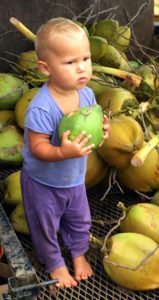 Another path is that of reinhabiting the Earth, place by place. This means learning to live with restraint, in ways that do not degrade either local or distant ecosystems. This will entail joining with others to localize our food and energy production, protect watersheds, restore native ecosystems, and defend the full diversity of species. This path is rooted in ecological literacy, love for the living world, and a willingness to get real about the implications of our actions for our children, grandchildren and all future generations. The challenge before us is to find our own ways to contribute, to step up as volunteers, as voters, and as leaders in our lives. This is the Great Work of our times, and will take our commitment both locally, and as a planetary species, united.
Another path is that of reinhabiting the Earth, place by place. This means learning to live with restraint, in ways that do not degrade either local or distant ecosystems. This will entail joining with others to localize our food and energy production, protect watersheds, restore native ecosystems, and defend the full diversity of species. This path is rooted in ecological literacy, love for the living world, and a willingness to get real about the implications of our actions for our children, grandchildren and all future generations. The challenge before us is to find our own ways to contribute, to step up as volunteers, as voters, and as leaders in our lives. This is the Great Work of our times, and will take our commitment both locally, and as a planetary species, united.
For nature lovers, Hawaiʻi’s story can be disheartening. Much harm has already been done, and much has been lost that can never regained. Yet there is so much left to celebrate. Whale songs still fill the winter waters. Spiny lobsters ply the reefs. Flashes of red and yellow feathers still dart among the trees of mountain forests. In the depths of rarely visited valleys, obscure little creatures continue to evolve, finding new and better ways to do what they do. May we do the same – and with aloha.
REFERENCES
AAP (2012) Pesticide Exposure in Children. Policy Statement, Council on Environmental Health of the American Academy of Pediatrics. Pediatrics 130(6): e1757-e1763. http:// pediatrics.aappublications.org/content/130/6/e1757.full.html
Carson HL. Feb 1982. Evolution of Drosophila on the newer Hawaiian volcanoes. Heredity (Edinb).;48(Pt 1):3-25.
Chinen, Jon J. 1966. The Great Mahele: Hawaii's Land Division of 1848. (Honolulu): University of Hawaii Press.
Cox, Barry, Richard Ladle, Peter D. Moore. 2016. Biogeography: An Ecological and Evolutionary Approach
Cowie, Robert H, Brenden S Holland. 27 October 2008. Molecular biogeography and diversification of the endemic terrestrial fauna of the Hawaiian Islands Phil. Trans. R. Soc. B 2008 363 3363-3376
Cuddihy, Linda and Charles Stone. 1990. Alteration of Native Hawaiian Vegetation: Effects of Humans, their Activities, and Introductions.
Freese, Bill, et al. 2015. Pesticides in Paradise: Hawaiʻi's Health and Environment at Risk. Center for Food Safety. http://www.centerforfoodsafety.org/reports/3901/pesticides-in-paradise-hawaiis-health-and-environment-at-risk
Fritz, Angela. March 30, 2016. Scientists say Antarctic melting could double sea level rise. Here’s what that looks like. https://www.washingtonpost.com/news/capital-weather-gang/wp/2016/03/30/what-6-feet-of-sea-level-rise-looks-like-for-our-vulnerable-coastal-cities/?tid=a_inl
Givnish, Thomas J et al. 7 February 2009. Origin, adaptive radiation and diversification of the Hawaiian lobeliads (Asterales: Campanulaceae) Proc. R. Soc. B 2009 276 407-416;
Givnish T. October 2010. Ecology of plant speciation TAXON 59: 1326–1366
Goldfarb, Audrey. July 18, 2016. Rapid 'Ohi'a Death Threatens Habitat for Hawaiʻi's Forest Birds. https://abcbirds.org/rapid-ohia-death-threatens-habitat-for-hawaiis-forest-birds/
Grigg , Richard. 2014. Archipelago, The Origin and Discovery of the Hawaiian Islands.
Handy, Handy and Pukui. Native Planters in Old Hawaii: Their Life, Lore, and Environment.
Hawaii Snail Extinction Prevention Program: http://dlnr.hawaii.gov/ecosystems/hip/sep/
Kanahele, George Hu'eu Sanford. 1986. Ku Kanaka, Standing Tall, A Search for Hawaiian Values. UH Press.
Kaua'i Forest Bird Recovery Project 2016. Threats to Native Forest Birds
http://kauaiforestbirds.org/birds/threats-to-native-birds/
Koberstein, Paul (June 16, 2014). GMO companies are dousing Hawaiian island with toxic pesticides. http://grist.org/business-technology/gmo-companies-are-dousing-hawaiian-island-with-toxic-pesticides/
Liebherr JK (2015) The Mecyclothorax beetles (Coleoptera, Carabidae, Moriomorphini) of Haleakala-, Maui: Keystone of a hyperdiverse Hawaiian radiation. ZooKeys 544: 1-407.
Moore, J.G., et al. (1989) Prodigious Submarine Landslides on the Hawaiian Ridge. Journal of Geophysical Research. 94:17,465-17,484
NOAA. “Fish species unique to Hawaii dominate deep coral reefs of the Northwestern Hawaiian Islands 3/13/14. http://sanctuaries.noaa.gov/news/press/2014/pr031314.html
O’Grady, Patrick, and Rob DeSalle. “Out of Hawaii: The Origin and Biogeography of the Genus Scaptomyza (Diptera: Drosophilidae).” Biology Letters 4.2 (2008): 195–199. PMC. Web. 1 Sept. 2016
Olson, Steve. (2004) Evolution in Hawaii: A Supplement to 'Teaching About Evolution and the Nature of Science'. National Academy of Sciences. Chapter: An Adaptive Radiation Has Led to a Dramatic Diversification of the Drosophilids in Hawaii. https://www.nap.edu/read/10865/chapter/7
Pala, Christopher. 2015, August 23. Pesticides in paradise: Hawaii's spike in birth defects puts focus on GM crops. The Guardian. https://www.theguardian.com/us-news/2015/aug/23/hawaii-birth-defects-pesticides-gmo
Price, Jonathan P. "Floristic Biogeography of the Hawaiian Islands: Influences of Area, Environment and Paleogeography." Journal of Biogeography 31.3 (2004): 487-500. Web.
Schmitz, P. and Rubinoff, D. (2011), The Hawaiian amphibious caterpillar guild: new species of Hyposmocoma (Lepidoptera: Cosmopterigidae) confirm distinct aquatic invasions and complex speciation patterns. Zoological Journal of the Linnean Society, 162: 15–42.
USGS Hawaiian Volcano Observatory. 2003. Once a big island, Maui County now four small islands. http://hvo.wr.usgs.gov/volcanowatch/archive/2003/03_04_10.html
Wikipedia: Surtsey. https://en.wikipedia.org/wiki/Surtsey
Wilmshurst, Janet M. et al. 26 October 2015. "High-precision radiocarbon dating shows recent and rapid initial human colonization of East Polynesia", PNAS, vol. 108 no. 5, doi: 10.1073/pnas.1015876108
